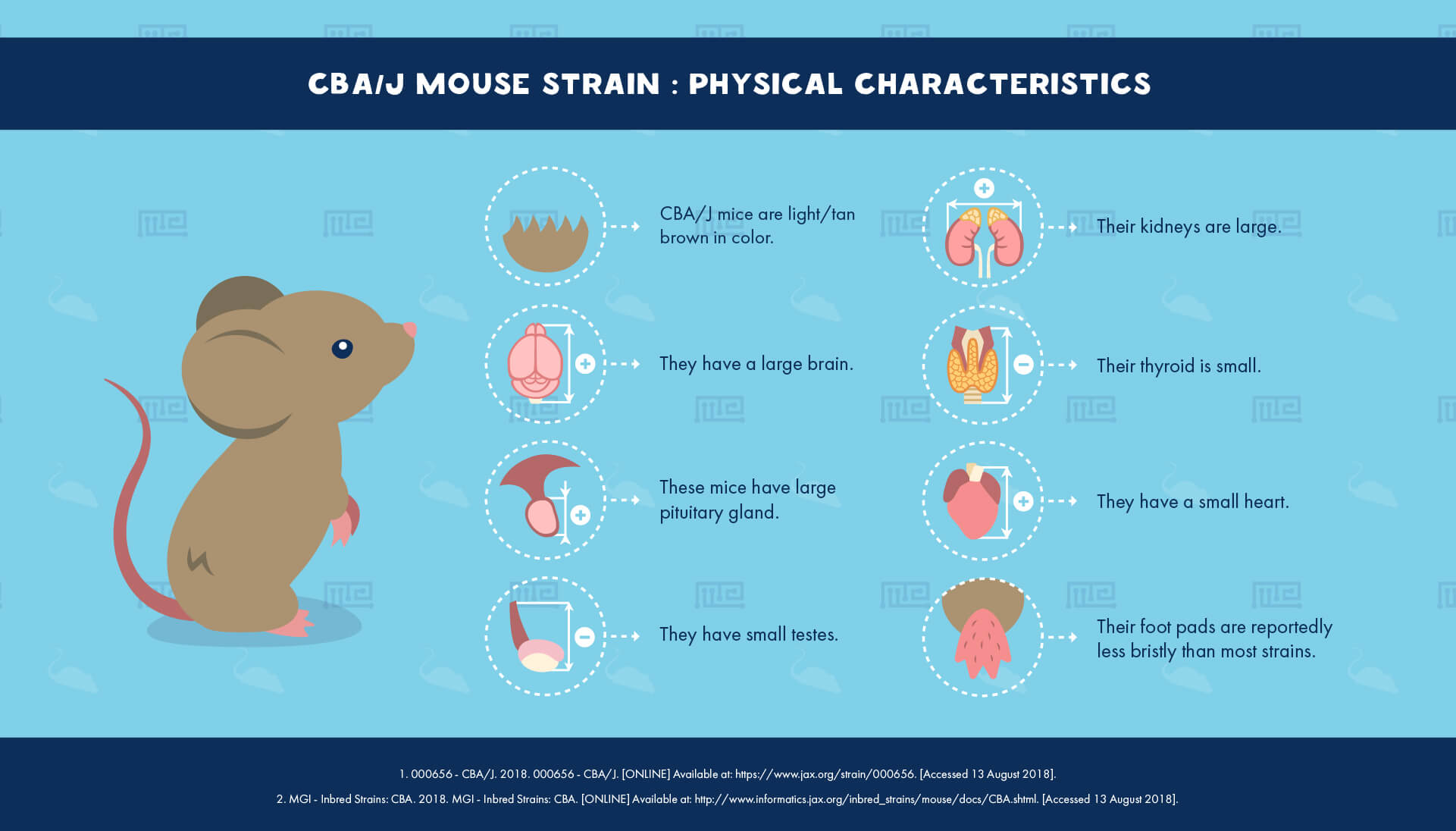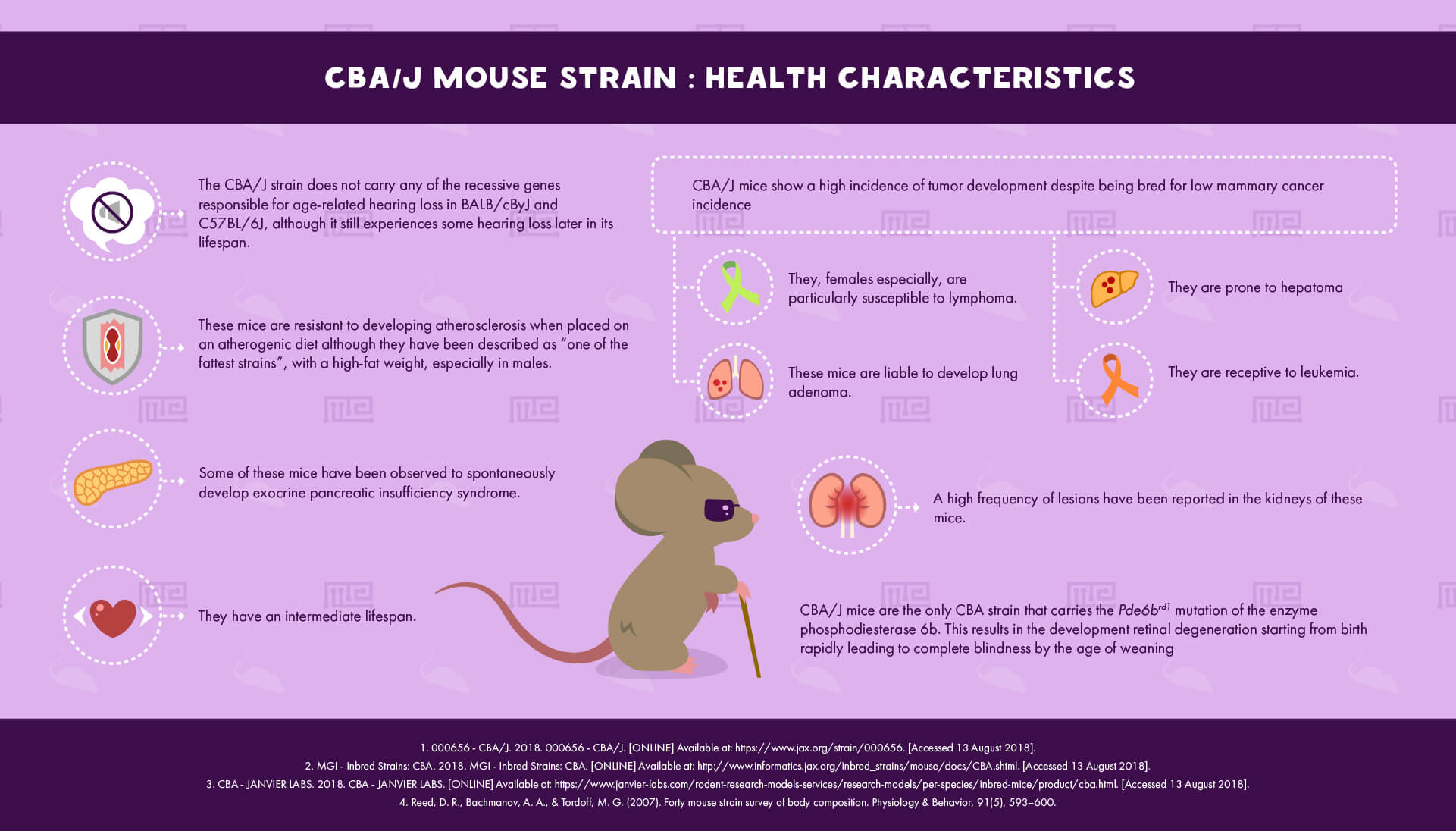Overview
CBA/J is a popular strain of inbred mouse model used in a wide variety of research applications. It is especially noted for its congenital early-onset blindness.
History
The ancestral CBA strain was developed by Strong in 1920, who crossed a DBA mouse with a Bagg albino mouse. He then selectively bred for a low incidence of breast cancer. CBA mice were obtained by Andervont in 1947, who then passed them to the Jackson Laboratory in 1948, where the CBA/J strain was developed.[1][2][3][4]
The substrains of CBA have diverged to such an extent over the years that they are no longer genetically compatible; such a large divergence is unlikely to be solely due to genetic drift and may have resulted from some kind of contamination.[3]
Behavioral Characteristics & Handling
One study provides evidence for low aggression in this strain.[5] Low spontaneous locomotor activity is also reported.[3] Hence, it would be expected that CBA/J mice would respond well to handling, with minimal evasive behavior, struggling or biting during capture and holding. Although, no research is available specifically looking into the ease of handling of this strain.
Breeding performance is described as good to intermediate, with large litter sizes.[3] One study reports that mice of this strain spent an unusually large amount of time sleeping.[6] They are also susceptible to catalepsy i.e. pinch induced freezing.[3]
CBA/J mice perform badly in both the radial arm maze and Morris water maze, which suggests a deficit in spatial learning and memory.[7] One study reports that this strain shows low immobility in the forced swimming test, a result associated with low depressive mood, and linked by the researchers here with altered dopaminergic activity in the brain.[8]
Health Characteristics
CBA/J mice are the only CBA strain that carries the Pde6brd1 mutation of the enzyme phosphodiesterase 6b; as a consequence, they develop retinal degeneration starting from birth, which leads rapidly to complete blindness by the age of weaning.[1][4]
Lifespan for this strain is described as intermediate.[3] While this strain has been bred for low mammary cancer incidence, high incidence of tumor development is still reported; in particular, CBA/J mice are susceptible to lymphoma, especially in females, as well as hepatoma, lung adenoma and leukemia.[3]
The CBA/J strain does not carry any of the recessive genes responsible for the age-related hearing loss in BALB/cByJ and C57BL/6J, although it still experiences some hearing loss later in its lifespan.[3]
These mice are resistant to developing atherosclerosis when placed on an atherogenic diet (high fat, high cholesterol).[1] Despite this, CBA/J has been described as “one of the fattest strains”, with a high-fat weight, especially in males.[9]
Studies report a high frequency of lesions in the kidneys of these mice, and some have also been observed to spontaneously develop exocrine pancreatic insufficiency syndrome.[1][3][4]
Major Experimental Uses
This strain is frequently used to study granulomatous experimental autoimmune thyroiditis (G-EAT),[4] an inflammatory disease of the thyroid gland. In addition, CBA/J mice have played an important part in research into atherosclerosis, kidney abnormalities, pancreatic defects and enzyme deficiency, and hearing loss.[1]
References
- 000656 – CBA/J. 2018. 000656 – CBA/J. [ONLINE] Available at: https://www.jax.org/strain/000656. [Accessed 13 August 2018].
- Common Mouse Research Models. [ONLINE]. Available at: https://web.archive.org/web/20150724114553/https://www.research.uky.edu/dlar/documents/CommonMouseResearchModels.pdf [Accessed 20 July 2018].
- MGI – Inbred Strains: CBA. 2018. MGI – Inbred Strains: CBA. [ONLINE] Available at: http://www.informatics.jax.org/inbred_strains/mouse/docs/CBA.shtml. [Accessed 13 August 2018].
- CBA – JANVIER LABS. 2018. CBA – JANVIER LABS. [ONLINE] Available at: https://www.janvier-labs.com/rodent-research-models-services/research-models/per-species/inbred-mice/product/cba.html. [Accessed 13 August 2018].
- Southwick C. H. and Clark L. H. (1966) Aggressive behaviour and exploratory activity in fourteen mouse strains. Zool. 6, 559.
- Valatx J. L. and Bugat R. (1974) Facteurs gènètiques dans le determinisme du cycle veille-sommeil chez la souris. Brain Res. 69, 315-330.
- Brown, R. E., & Wong, A. A. (2007). The influence of visual ability on learning and memory performance in 13 strains of mice. Learning & Memory, 14(3), 134–144.
- Nikulina EM, Skrinskaya JA, Popova NK. Role of genotype and dopamine receptors in behaviour of inbred mice in a forced swimming test. Psychopharmacology (Berl). 1991;105(4):525-9.
- Reed, D. R., Bachmanov, A. A., & Tordoff, M. G. (2007). Forty mouse strain survey of body composition. Physiology & Behavior, 91(5), 593–600.


